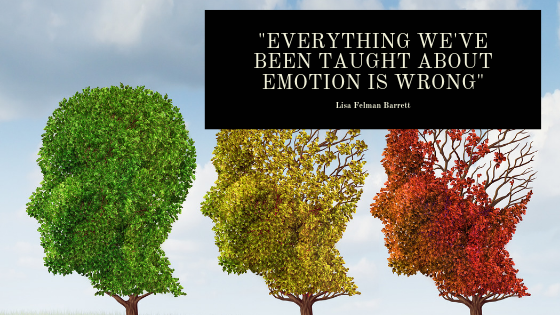Everything we have been taught about emotion is wrong. Our emotions are not hardwired they are predictions based on our experiences. Using past experience our brain constructs our current experience.
This is according to researcher, author and lecturer Lisa Feldman Barrett and her research over the past 20 years and the “newly discovered” research across decades that debunked the classical view of emotions that apparently remained hidden.
About Emotion – a snapshot
Emotions that we seem to detect in other people are actually coming from our own brain – this has great impact in our every day life – personally and professionally.
We cannot detect emotion in anybody, anywhere, EVER.
This has enormous implications for how we connect and judge others. This has enormous implications for our legal system, for any interpersonal communication, for investment in predictive tools based on facial expressions and body language, AI and so much more.
What we know about emotions NOW
- It may feel like our emotions are hardwired but they are NOT
- No brain on the planet has emotion circuits.
- Our emotions are guesses that our brain constructs in the moment – where billions of brain cells work together to create the best “guess”.
- Emotions are not built from birth -they are just built.
- Our brain is a predictive tool – it makes the best guess based on past experience.
- This happens within the blink of an eye
- Our brain may be prewired to make feelings like calmness, discomfort but there is little detail so you need to work with your brain to identify why you are having those feelings.
- Predictions link the feelings in your body with what is going on around you.
Key Lessons on Emotion:
- Emotions that you seem to detect in other people are actually created in our own head.
- Emotions which seem to happen to us, are actually made by us.
- Our emotions are not at the mercy of our brain
- We have a lot more control over our brain than we initially thought
- If you start changing some of your thoughts and processes today you can reengineer the way you respond to it.
- Can we transform emotional suffering into mild discomfort by reframing, regulating or repositioning.
- We can turn down the dial of emotional suffering by learning to turn down the dial with regulation practices.
- More control means more responsibility – so who is responsible when you behave badly – you are.
- The actions and behaviours you make today are how your brain will respond in the future.
Emotional Intelligence in Action
For example: an exam. A person feels dread over having to sit an exam.
Physiological: sweaty palms, hammering heartbeat, rumbling belly.
Your body is trying to explain the sensations. So this is our opportunity to reframe it before it is labelled as anxiety.
Reframe it: could be your body is preparing for battle to ace the test. Energised rather than anxiety – this has great implications.
Experiential blindness:
Have you ever seen those images where you have the old woman and the young women in the picture – for some they might not have been able to see this straight away? The next time you see the image you see it straight away. And the next time there is a similar image you will know that there is a hidden image within an other image and start to search for it.
This has great implications for parents and teachers as we expose our children to actions and behaviours in our home and schools.
There is a great example of a maths teacher who asked a classroom of children. “I am holding in my hand a 1meter long ruler, how long will the ruler be if I divide it into four”. One of the kids answered 1 meter long. The kids laughed, the teacher got frustrated and she repeated the question. The student answered again but with the same answer. The teacher then explained how the ruler would be divided into 4 equal parts, splitting the ruler into 25cm pieces. The student then, got up and showed the teacher that if the ruler was split across the width of the ruler – everyone would have a 1meter piece of ruler – it would just be really thin pieces.
What does this mean?
- Upskill in emotional intelligence
- Learn how to regulate our emotions – with reframing, repositioning, labelling, and a whole range of other strategies.
- Accept accountability for our own actions and learn how to regulate ourselves
People trying to detect emotion in face and body are looking in the wrong place. We need to make them meaningful with context.
Implications for our Emotions
So what does this mean? Our brain guesses based on past experience. So, we need to get curious. We need to ask questions and interact with others to understand how they are feeling.
Risks
We need to understand how our brain works to allow us to connect with others. Currently we are our own worst enemy in connecting or creating relationships.
Read the book on How Emotions are Made
I was introduced to Lisa Feldman Barretts book, “How Emotions are Made – the Secret Life of the Brain”, when I started studying Neuroscience in Leadership with Neurocapability. It is a book we should all read as it has profound implications for the way we engage, connect and build relationships at home and at work, and for how we do our jobs.
This is a great Ted X talk from Lisa Feldman Barrett
https://www.youtube.com/watch?v=0gks6ceq4eQ&feature=youtu.be

